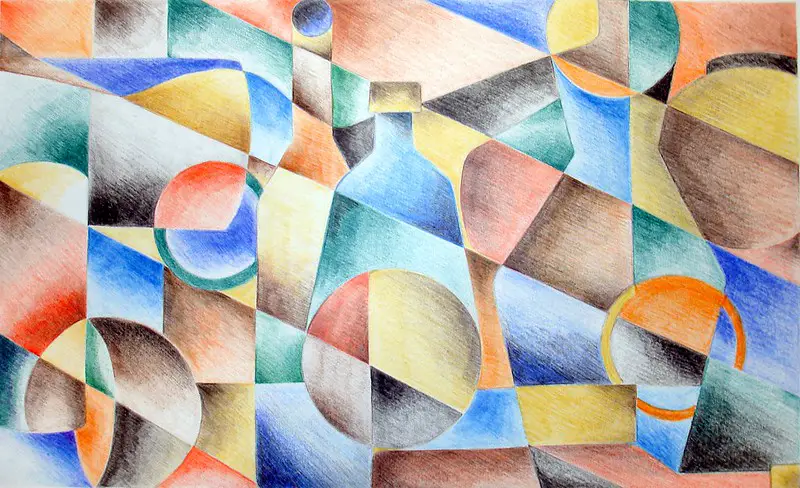Analytical cubism is characterized by the fragmentation of figures into individual planes and the use of geometric shapes to create abstracted forms. By contrast, Synthetic cubism takes a much more playful approach to composition, using bright colors and everyday objects to construct surrealist landscapes.
What is analytical cubism?
Analytical cubism was a revolutionary art movement that originated in the early 20th century, spearheaded by artists such as Pablo Picasso and Georges Braque. This movement aimed to break away from traditional representational art by deconstructing objects into their basic geometric shapes and representing them from multiple viewpoints simultaneously.
Analytical cubism is characterized by its use of monochromatic palettes, often restricted to shades of brown and gray, and its emphasis on form and structure over color and texture. It involves the analysis of the subject matter into its most basic forms and then reassembling them into a new, abstracted version.
The artists who practiced analytical cubism often worked in a series, exploring a single subject from multiple perspectives and breaking it down into its constituent parts. This approach allowed them to create works that challenged traditional modes of representation and invited the viewer to engage in a new way of seeing the world.
Analytical cubism was a groundbreaking movement that helped to pave the way for the development of modern art. Its emphasis on abstraction, multiple perspectives, and the deconstruction of form has had a lasting impact on the art world and continues to influence artists to this day.
What is synthetic cubism?

Synthetic cubism is a phase of the cubist art movement that emerged in the early 20th century and was pioneered by artists such as Pablo Picasso and Georges Braque. Unlike analytical cubism, which focused on breaking down objects into their basic geometric forms, synthetic cubism aimed to build up objects from those basic forms, creating more complex and abstract compositions.
Synthetic cubism is characterized by its use of vibrant colors, often applied in a flat, decorative manner, and its incorporation of new materials and techniques such as collage, which allowed artists to incorporate elements of popular culture and mass media into their work. Artists also experimented with the use of stencils, lettering, and other techniques borrowed from commercial design to create complex and layered compositions.
Another important characteristic of synthetic cubism was its incorporation of text and other signs and symbols, which served to further disrupt traditional notions of representation and meaning. By juxtaposing fragments of language and images, artists created works that were open to multiple interpretations and challenged viewers to engage with them in new ways.
Overall, synthetic cubism was a radical departure from traditional modes of representation and marked a turning point in the development of modern art. Its emphasis on abstraction, collage, and the incorporation of popular culture and mass media helped to pave the way for later movements such as Dada and Surrealism.
Analytical cubism Vs. Synthetic cubism – Key differences
(Photo by Steve Johnson on flickr)

Analytical cubism and synthetic cubism are two phases of the cubist art movement that emerged in the early 20th century. Here are some key differences between analytical cubism and synthetic cubism:
Approach: Analytical cubism is more concerned with breaking down objects into their basic geometric forms, whereas synthetic cubism is more focused on building up objects from those basic forms.
Techniques: Analytical cubists used a monochromatic palette, often restricted to shades of brown and gray, and focused on depicting objects from multiple viewpoints simultaneously. In contrast, synthetic cubists used more vibrant colors and experimented with collage and other techniques to build up objects in a more abstract manner.
Composition: Analytical cubist compositions tended to be more fragmented and abstract, with objects depicted from multiple viewpoints and often overlapping or intersecting. Synthetic cubist compositions were more cohesive, with objects built up from simple geometric forms and arranged in a more structured manner.
Subject matter: Analytical cubism focused on traditional subjects such as still life and portraiture, whereas synthetic cubism often incorporated elements of popular culture and mass media, such as advertisements and newspaper clippings.
Timeline: Analytical cubism is generally considered to have been the first phase of cubism, lasting from roughly 1907 to 1912, while synthetic cubism emerged in the years that followed and lasted until around 1914.
Analytical cubism is characterized by its focus on breaking down objects into their basic geometric forms, while synthetic cubism is more concerned with building up objects from those forms. Analytical cubism uses a limited color palette and depicts objects from multiple viewpoints, while synthetic cubism employs vibrant colors and collage techniques to create more abstract compositions. Additionally, analytical cubism focused on traditional subject matter, while synthetic cubism incorporated elements of popular culture.
What is the main difference between synthetic and analytic geometry?
Synthetic geometry and analytic geometry are two different branches of geometry.
The main difference between synthetic and analytic geometry lies in their methods of proof and approach. Synthetic geometry, also known as Euclidean geometry, is a traditional form of geometry that focuses on the study of points, lines, angles, and shapes in two- and three-dimensional space. In synthetic geometry, the emphasis is on the use of deductive reasoning and logical proofs to arrive at a conclusion. Synthetic geometry often relies on postulates, axioms, and theorems to prove results.
On the other hand, analytic geometry, also known as coordinate geometry, is a modern form of geometry that uses algebraic techniques and Cartesian coordinates to study geometric shapes and their properties. Analytic geometry is based on the principle that geometric shapes and properties can be described using equations and algebraic formulas. In analytic geometry, the emphasis is on the use of algebraic techniques, such as equations and graphs, to study geometric properties and relationships.
The main difference between synthetic and analytic geometry is that synthetic geometry relies on logical proofs and deductive reasoning to establish geometric results, while analytic geometry uses algebraic methods and coordinates to study geometric shapes and properties.
What is the difference between analytic and synthetic transformation?
Analytic and synthetic transformations are two different approaches to studying geometric transformations.
Analytic transformations refer to transformations in which geometric shapes are transformed by applying mathematical formulas and coordinate systems. In analytic transformations, the focus is on using algebraic equations and coordinates to describe and study transformations such as translations, rotations, and reflections. Analytic transformations are often used in analytic geometry and computer graphics, where transformations are computed using matrices and other mathematical operations.
Synthetic transformations, on the other hand, refer to transformations that are studied using traditional geometric methods and constructions, without relying on algebraic formulas or coordinate systems. In synthetic transformations, the focus is on using geometric tools such as compasses and straightedges to construct and study geometric shapes and transformations. Synthetic transformations are often used in Euclidean geometry and are based on the use of axioms, postulates, and theorems to study geometric properties and relationships.
The main difference between analytic and synthetic transformations is that analytic transformations rely on algebraic formulas and coordinate systems to describe and study transformations, while synthetic transformations rely on traditional geometric methods and constructions to study geometric transformations.
Featured Image By – Ray Shrewsberry • from Pixabay







